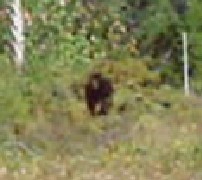One Million Species & Counting
Posted by: Loren Coleman on April 9th, 2007

Of course, the criteria for making the cut via the complex gathering described here will not apply to the cryptids seen, photographed – such as this unknown ape above in Florida – but not taken. Will it become the new yardstick of the future?
The Catalogue of Life, available on CD and on the Internet (www.catalogueoflife.org), is the result of a worldwide collaboration involving so far about 50 contributing databases and the work of 3,000 biologists. The project plans to cover all estimated 1.75 million known species by 2011.
The project is led by the University of Reading’s Professor Frank Bisby of the Species 2000 organisation, based at the University’s Centre for Plant Diversity and Systematics, and by Dr Thomas Orrell, of the Integrated Taxonomic Information System (ITIS) based at the Smithsonian Institution, National Museum of Natural History, Washington DC.
Professor Bisby said: “This electronic checklist is the modern successor to the work started by Linnaeus whose 300th birthday is celebrated this year. It now delivers one million of the world’s described species, from whales to bacteria, mosses to moths, seaweeds to viruses.”
Dr Orrell said: “The catalogue will cover all known living organisms, such as plants, animals and fungi, and micro-organisms such as bacteria, chromista, protozoa, archaea and viruses.”
A joint biological and informatics team integrates information from individual databases in the taxonomic classification. Information on exactly which species should be recognised is validated by experts before being integrated, a vital difference compared to some other catalogues available on the Internet.
The project is on course to deliver the fundamental organism catalogue needed both by the present generation of international biodiversity programmes and the next generation now in planning, such as the Global Species Information System proposed by the G8 Environment Ministers in Potsdam two weeks ago.
It is a keystone component in building the world’s biodiversity knowledge systems of the future. It also facilitates analytical systems working on species, such as modelling and predicting climate change outcomes on a global scale.
Manuela Soares, Director for Research (Environment) at the European Commission will mark the occasion in Reading on 29 March by presenting copies of the One Million Species Catalogue to leaders of major global biodiversity and conservation programmes at the start of a one-day Symposium.Lucy Ferguson | Quelle: alphagalileo
Weitere Informationen: Catalogue of Life | Species 2000
nächste Meldung
About Loren Coleman
Loren Coleman is one of the world’s leading cryptozoologists, some say “the” leading living cryptozoologist. Certainly, he is acknowledged as the current living American researcher and writer who has most popularized cryptozoology in the late 20th and early 21st centuries.
Starting his fieldwork and investigations in 1960, after traveling and trekking extensively in pursuit of cryptozoological mysteries, Coleman began writing to share his experiences in 1969. An honorary member of Ivan T. Sanderson’s Society for the Investigation of the Unexplained in the 1970s, Coleman has been bestowed with similar honorary memberships of the North Idaho College Cryptozoology Club in 1983, and in subsequent years, that of the British Columbia Scientific Cryptozoology Club, CryptoSafari International, and other international organizations. He was also a Life Member and Benefactor of the International Society of Cryptozoology (now-defunct).
Loren Coleman’s daily blog, as a member of the Cryptomundo Team, served as an ongoing avenue of communication for the ever-growing body of cryptozoo news from 2005 through 2013. He returned as an infrequent contributor beginning Halloween week of 2015.
Coleman is the founder in 2003, and current director of the International Cryptozoology Museum in Portland, Maine.










One Million insects and just 29 million to go.
It’s a tough job, but somebody’s gotta do it!
They have catalogued 82 species of Krill. AMAZING!!! You gotta have one super microscope for that.